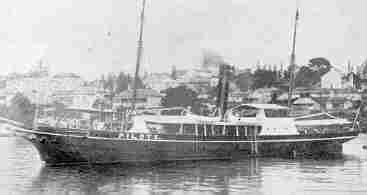
attempted to assist the Centurion
My Photos 1
From the webpage of Michael McFadyen
The Centurion was a timber barque constructed by Walter Hood & Sons in Aberdeen, Scotland in 1864. She was 63 metres long and displaced 1004 tons. I do not yet know much of the early history of the vessel but from 1870 till 1887 she was a common sight on the route between London and Sydney.
On the morning of Sunday 16 January 1887, "one of the most extraordinary accidents to shipping that has been recorded for a long time past happened..." (Sydney Morning Herald 17 January 1887).
At 1am that Sunday morning, the Centurion left its wharf at Dawes Point (at the spot on the southern side of the Harbour where the Sydney Harbour Bridge now stands) being towed by the J. & A. Brown steamer Pheobe. The Centurion was loaded with 400 tons of coal and was bound for Honolulu via Newcastle. Under the command of Captain Sutherland of the Phoebe, the two vessels proceeded down the Harbour for the open ocean. As they neared the Heads, another barque, the Manhegan, was seen to be anchored right in the middle of the Heads.
Captain Sutherland saw that if he kept going they would get tangled up with the Manhegan. At the same time, massive rain squall appeared dropping visibility to almost zero. He therefore put his engines into reverse. Unfortunately, the tow rope went slack and got fouled around the Phoebe's prop. As you could imagine, this caused a lot of problems. The Centurion drifted towards the rocks at North Head and very soon the tow line was cut by the prop. The Centurion was now going towards the rocks so Captain Charles Taylor (this was his first trip on the Centurion) let an anchor go but under the strong southerly blowing, the ship was soon aground near Old Mans Hat (halfway between the Inner and Outer Head).
 |
| The famous Captain Cook pilot vessel attempted to assist the Centurion |
The Centurion is now located just off Quarantine Point, well inside the Heads. This is many hundreds of metres from where it is supposed to have hit the rocks. In about 18 metres of water on a sandy bottom, the wreck consists of twisted iron, masts, timber and some other pieces of the ship. The wreck is in two parts, with a major section of the wreck located under the sand.
While the actual wreck site is not very large and can be explored in 15 minutes or so, the wreck has attracted a lot of fish life which greatly adds to the quality of the dive.
A very good good introductory wreck dive or also good as a night dive. The visibility here is never very good, but more than enough to enable you to enjoy the dive.